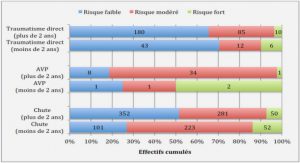Model of ray-tracing in planar waveguides
Mode propagation in planar waveguides can be described by 2D ray-tracing [108]. Rays in the waveguide represent the direction of energy flow in the mode. I will call these rays “surface rays”, since they propagate in 2D, parallel to the substrate surface of the waveguide. In order to calculate refracted ray directions and optical paths, one needs the refractive indices in the different waveguide regions – for this purpose I use the effective refractive indices of a given waveguide mode [66, 108].
Model of anisotropy
In this subsection, a summary of the model I applied in my computer routines is given; theoretical background of anisotropy can be found in [11], [103], [54], [55], [115] and [17]. Since the substrate material used in our laboratory is LiNbO3, I apply the model of uniaxial anisotropy corresponding to the optical properties of this crystal. I approximate the inverse velocity curve (i.e. the 2D “surface” of wave-vectors) with an ellipse [56] as described in [1]. In case of waveguides, anisotropy means that the effective index is direction dependent, which affects ray tracing in two respects. First, to calculate the angle of refraction of the wavefront normal (wave vector), the direction dependent refractive indices must be substituted into formally the same expression as that of Snell’s law. The second effect is the deviation of the direction of the wave vector from that of the ray vector (which is parallel to the Poynting vector). In geometrical optical approximation the intensity distribution of a beam is determined by the Poynting vector (see spot diagrams), therefore one must use the “non-Snellian” refraction law of the rays instead of the one related to wavefront normals. There is a third phenomenon too: wavefronts emitted by a point source in a uniaxial material are of elliptical shape. Consequently, the algorithm (based on isotropic Fourier optics), by which OSLO computes the diffraction pattern of the focal spot, should also be altered. However, as the change of the intensity distribution due to wavefront ellipticity – and to uniaxial anisotropy in general – was shown [17] to be negligible in most cases of practical interest, the original algorithm can be used. In case the optical axis of a uniaxially anisotropic substrate material lies in the plane of the waveguide (which is exclusively subject to my consideration here), the curve of (effective) refractive indices can be best approximated by an ellipse [56]. Fig. III.1 shows the connection between the directions of the wave vector and the ray vector in such an anisotropic medium. Fig. III.2 depicts the condition of phase matching for wave vectors at the border line (corresponding to a conventional refractive “surface”) of two adjacent anisotropic regions having different refractive indices.
In- and outcoupling of a finite beam with a prism
If waveguide leakage is stopped at the end of the incident beam, the mode will propagate further in the waveguide without attenuation (neglecting losses caused by scattering on inhomogeneities etc.). This is satisfied if the incoming beam is positioned at the edge of the incoupler prism (see Fig. III.16). Outcoupling takes place the opposite way (see Fig. III.4). As the mode reaches the edge of the outcoupler prism, its intensity gradually decreases to zero because of mode leakage. The mode profile in the “Z” direction will be the same as the decreasing part of an incoupled finite beam. The outcoupled beam is phase-matched to the waveguide mode. The small phase-shift through the air-gap and the propagation-constant modification here also occur.
Introduction to anisotropic aberrations
Effects of optical anisotropy on the imaging properties of planar waveguide lenses have been investigated by several authors. These papers reveal large defocusing and focal spot deterioration (similar to spherical aberration) in optical systems designed with the usual approximation that characterise anisotropic lens materials with isotropic refractive indices. The main types of methods (all of which having some deficiencies) used for correction of anisotropic aberrations are listed below.
a) The simplest way is to calculate analytically the necessary lens profile. Due to the approximations incorporated, this is sufficient only for small field-angle 2D isotropic singlets [113, 111].
b) 3D design programmes (without modification) can simply treat 2D isotropic systems. In this way wide field-angle (aplanatic, etc.) lens systems can be designed [65, 84].
c) If anisotropy has to be taken into account, the designer must develop his own design software [56, 103]. The length of time required to write such a program is usually not acceptable.
d) Non-ray-tracing methods. Beam propagation methods [52, 79, 18] can analyze only low numeri-cal aperture lens systems with a narrow field-of-view, and they are also too slow for optimisation.
Geometrical optical interpretation – second approximation
In the previous subsection I assumed that all the outcoupled rays are in the meridional plane in the prism; now I examine the position of these rays in the prism, after outcoupling. For simplicity, let us suppose that all the surface rays pass through point “P”, situated on the prism edge “L” (see Fig. III.10). Since all these rays couple out under the same angle with respect to the waveguide plane (corresponding to the synchronous direction), the surface that these kprism wave vectors form in the prism is a cone, denoted by “K” in Fig. III.10. The assumption in the previous subsection that this surface can be approximated by a plane is thus strictly valid only for situations when the surface rays are nearly perpendicular to the prism edge. Although this is often the case, in reality the two effects shown above superimpose to determine the direction of outcoupled rays after the prism, i.e. in air.
Preliminaries (Former methods for the design of beam-shapers)
In this chapter I briefly overview the methods previously developed by different authors for the design of beam shaping devices that produce a spatially coherent output beam of uniform intensity with spherical/plane wavefronts [43, 83, 59, 53, 89, 45, 60, 86]. Most of the existing design methods rely on a specific device structure (already mentioned in the introduction), according to which such systems consist of two sequentially placed optical elements (sub-systems): optical element #1 performing intensity shaping, and optical element #2 collimating the output beam. A simple demonstrative example for such a beam shaping system is depicted in Fig. IV.2, which device has been first described by S. R. Jahan and M. A. Karim [59, 53]. The instrument is a refractive device with two aspheric surfaces. The input surface corresponds to optical element #1, while the output surface corresponds to optical element #2. In other realisations of beam shaping systems, e.g. diffractive elements or spherical subsystems can also be used instead of the two aspheric surfaces. Physical (i.e. diffractive) and geometrical optical models are equally used for the design of beam shapers, applying both analytic and numerical methods (for this latter see further details in the next subsection). The system specification is generally expressed by two requirements: the intensity and the phase condition. The former refers to intensity reshaping (described by the map function), while the latter refers to the shape of the input and output wavefronts (e.g. collimated or spherical beam).
Optimisation method for the design of beam shaping systems
As I concluded in Subsection IV.3.2, to my knowledge no local optimisation methods have been applied for the design of beam-shapers until now. In this subsection I present a method that fills this gap by providing a new design tool for optical engineers. The main advantage of the method is that it does not require special softwares, since it is integrated into the convenient, accustomed environment of commercial design programmes, offering an aid at the design of complex optical systems containinga wide range of beam shaping elements. It has been presented in Subsection IV.2.3 that intensity and phase variations in a circular beam of light can be described (with given limitations) by geometrical optical means using meridional ray-tracing. In my method I use the map function to specify the required intensity transformation for the optical design programme. First, I define a collimated input beam by the ray heights r(i) of a set of ‘n’ meridional parallel rays on the input surface of the beam shaping system (i = 1, 2, … , n).
Imaging by a hybrid lens in the presence of multiple diffraction orders
In the previous paragraph, the DOE was assumed to work in one single (viz. the first) diffraction order. This requirement can never be satisfied perfectly if the device is operated not at its nominal wavelength (or for binary optics etc.). In such cases, an infinite number of orders are present (the coherent superposition of which forms the image), thus the image quality will decrease in a certain extent. In this subsection, I discuss those basic phenomena that can be observed when non nominal orders of the DOE are taken into account in the optical analyis of hybrid systems, especially when the working wavelength (λ) of the DOE is different from the nominal one (λ0). Until more precise design methods have been developed, considerations originated in the phenomena presented below served as a basis to estimate the effects of higher diffraction orders on the image quality of hybrid lenses.
|
Table des matières
PREFACE
ACKNOWLEDGEMENTS
THESES
PUBLICATIONS
OTHER, RELATED PUBLICATIONS
I GENERAL INTRODUCTION
II OVERVIEW OF COMMERCIAL OPTICAL DESIGN PROGRAMMES
1 MAIN FEATURES OF OPTICAL DESIGN PROGRAMMES
2 EXTENDING THE CAPABILITIES OF COMMERCIAL SOFTWARES
III MODELLING AND DESIGN OF HYBRID WAVEGUIDE/BULK SYSTEMS
1 INTRODUCTION
2 FUNDAMENTALS
3 PRELIMINARIES (FORMER CONSIDERATIONS CONCERNING ANISOTROPY AND PRISM-OUTCOUPLED BEAMS)
4 RESULTS (EFFICIENT METHOD TO DESIGN WAVEGUIDE LENS SYSTEMS, AND THEIR OPTIMISATION)
5 APPLICATION EXAMPLES
6 VERIFICATION
7 CONCLUSION
IV DESIGN OF BEAM TRANSFORMATION SYSTEMS
1 INTRODUCTION
2 FUNDAMENTALS
3 PRELIMINARIES (FORMER METHODS FOR THE DESIGN OF BEAM-SHAPERS)
4 RESULTS (NEW METHOD FOR THE DESIGN OF BEAM-SHAPERS)
5 APPLICATION EXAMPLES
6 VERIFICATION
7 CONCLUSION
V ACCURATE MODELLING OF HYBRID DIFFRACTIVE/CONVENTIONAL OPTICAL SYSTEMS
1 INTRODUCTION.
2 FUNDAMENTALS
3 PRELIMINARIES (STANDARD MODELLING TECHNIQUE, AND THE IMAGING PROPERTIES OF DOES)
4 RESULTS (NEW DOE MODELLING TECHNIQUE AND ITS EFFICIENT IMPLEMENTATION)
5 APPLICATION EXAMPLES
6 VERIFICATION
7 CONCLUSION
VI GENERAL CONCLUSIONS
REFERENCES
APPENDIX A – USERS’ GUIDE TO “RS_DIFFR.EXE”
APPENDIX B – EFFECTS OF SAMPLING ON THE ACCURACY OF “RS_DIFFR.EXE”
APPENDIX C – PROGRAMME LISTING OF “RS_DIFFR.EXE”
APPENDIX D – GIBBS PHENOMENON AT MULTIPLE DIFFRACTION ORDER SUMMATION
APPENDIX E – GLOSSARY ON DEFINITIONS AND ABBREVIATIONS
APPENDED JOURNAL PAPERS
ABSTRACT
![]() Télécharger le rapport complet
Télécharger le rapport complet






